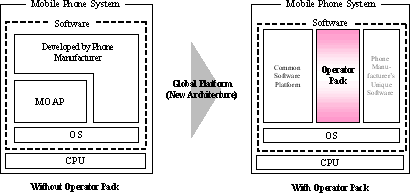The pack will contain a suite of operating system-based software applications that implement i-mode™, i-appli™ and other unique DoCoMo services. It will make use of existing assets developed by DoCoMo, including application software and MOAP™ (Mobilephone Oriented Application Platform) middleware now used in selected DoCoMo handsets.
Currently NTT DoCoMo phones are either based on MOAP-L (Linux) or MOAP-S (Symbian); these are used by NEC and Panasonic (MOAP-L) and Sony Ericsson, Fujitsu and Sharp (MOAP-S) respectively [Mitsubishi, which used MOAP-S, recently announced it intention to leave the mobile phone market].
MOAP provides a certain amount of middleware, but phone manufacturers needed to add their own software and application to produce a finished product (one of the reasons why MOAP phones from different manufacturers had different looking UIs).
The Operator Pack will mean a greater amount of the software stack is provided as part of the global platform. In one sense this should see MOAP phones become more like other software platform (S60, UIQ, Windows Mobile) - a global platform with differentiation achieved through unique applications and services. It should also see more commonality across phones from different manufacturers. It will reduce development costs, speed time to market and allow manufacturers to concentrate on differentiation rather than generic applications.
Intriguingly the adoption of a global software platform should allow the manufacturers to more easily market their devices overseas. Currently devices designed for the Japanese market are not made available overseas (although some, with GSM roaming, do work).
The strategy also underlines how powerful NTT DoCoMo's hold over its phone manufacturer partners is.
Here's NTT DoCoMo's graphic explaining the new architecture:

NTT DoCoMo has a press release on the news here. It concentrates on the Linux variant (noting its compatibility with LiMo specifications and that the software platform will be developed in conjunction with ACCESS (who are also developing the ALP software platform - descendant of Palm OS). However it also notes that an Operator Pack / software platform will also be developed based on Symbian OS. Devices using the software platforms will reach the market in the second half of 2009.
The news underlines the trend of the OS and middleware (and increasingly the standard applications) becoming a commodity component.
